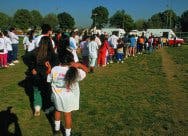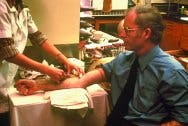The community phlebotomy response plan: How does your facility measure up?
Does your facility have a plan in place to handle community emergencies of this magnitude? If not, how would you assemble a team and ensure availability of necessary equipment, supplies, transportation, and laboratory support services?
The scenario outlined above is not fictitious. It happened at our facility, Queen Elizabeth II Health Sciences
Centre, Halifax, N.S. Canada, and we were ill-equipped to respond. We managed to handle the emergency call, but we faced problems in our efforts because we had never considered planning for a community emergency. Since then, our laboratory has participated in two more community emergencies requiring a phlebotomy team. One of these involved collection of blood samples for DNA testing on approximately 200 family members of victims of an air disaster who were flown in from around the world and accommodated at a local hotel. The disaster occurred on a long weekend, when many phlebotomists were unavailable. The third situation, fortunately, was well organized. A plan had already been created prior to the arrival of approximately 2,500 international refugees requiring a safe environment until they could safely return home.
Following the first incident, a committee was formed to discuss and improve our response initiative. The committee included a phlebotomist involved in both incidents, a supervisor of blood collection services, and a medical laboratory technologist. Observations were documented and problems identified. After discussing the issues concerning notification, communication, response team communication, and availability of equipment, a list of questions evolved questions that should have been addressed prior to the emergency.
- What is the chain of command?
- How many collections will be required?
- What time restrictions are there surrounding the collections?
- How many samples are expected per phlebotomist, per hour?
- How many hours in a high-stress situation are phlebotomists expected to work?
- Will replacements for the initial response team be required after a certain length of time?
- Based on the above, how many phlebotomists are required?
- How will specimens be transported all at once, following completion of collections, or at specified intervals (i.e., hourly).
- Who is responsible for supplying equipment and supplies?
- Who is responsible for obtaining and transporting equipment and supplies to the testing laboratory?
- Will response team phlebotomists assemble at the laboratory to pick up lab coats, tourniquets, and related equipment?
- What transportation will be necessary for response team members, and how will this be coordinated?
- Are additional laboratory technologists needed to perform testing on samples once they are received in the laboratory? If so, how will this be coordinated?
- Is there a current list of contact telephone numbers for phlebotomists?
- Are all phlebotomists committed to participation on the response team?
- Who is the contact person at the response site to meet and brief phlebotomists on arrival?
- How will resident, patient, or victim identification be made prior to collection of samples?
- Who is responsible for preparing requisitions and sample identification labels?
- How do response team members communicate and give/receive progress reports?
- Who will cover the cost of the response the Department of Health, the community facility, the hospital, or other?
A number of smaller concerns were also identified, including transportation of the team to and from the laboratory, as well as funding for parking and meals, if necessary.
A chain of command and communication fan-out had not been established for a situation of this type. This created much confusion and slowed response efforts. Valuable time was wasted trying to establish who had the authority to approve and initiate a response, and what chain of command would result in a viable response effort. In order for the plan to be effective, it was important that the chain of command included representatives from blood collection services, laboratory support services, and the laboratories that would be involved in testing samples.
Consideration had to be given to the number of collections required and the time frame for collection and testing. The number of phlebotomists necessary had to be calculated based on the total collections, time frame, and the number of samples expected per phlebotomist per hour. It was decided that the phlebotomists would be replaced after four hours to reduce the risk of fatigue and stress-related errors.
The decision on whether to transport samples en masse or transport in smaller batches could only be made following discussion with designated representatives from the laboratories that would be involved in testing. Contact representatives in all laboratory disciplines had to be identified before establishing a chain of command.
Priorities in preparing a response plan were preparation of a list of volunteers who showed interest in becoming members of the community phlebotomy response team, and maintaining a current telephone directory for contact.
In addition, there was uncertainty concerning the process of transporting samples to a central location for transport to the laboratory. A team leader and portable phones would have been a great asset.
Possible solutions to the problems discussed by committee members, drawing on their specific areas of expertise. Further brainstorming sessions were held, and a draft response plan was prepared. During this time, the second community emergency occurred, requiring a response from the phlebotomy team. This emergency involved an air disaster and included considerations unique to the situation.
| COMMUNITY PHLEBOTOMY RESPONSE SUPPLY KIT
|
Whereas the first community emergency involved collection of samples by venipuncture, testing on family members of the air disaster victims involved skin puncture to obtain samples for DNA testing. Because our institution is an adult facility performing mainly venipuncture procedures, many of our phlebotomists had only minimal experience performing skin punctures and no experience with pediatric collections. Therefore, response efforts were coordinated with phlebotomists and nurses from our neighboring childrens hospital to ensure a proper mix of skills. In addition, response team members had to be briefed by a representative from the forensic testing laboratory on proper collection techniques for DNA testing, avoiding introduction of foreign DNA.
Family members were to be lodged at a local hotel; therefore, workstations were assembled onsite. Initially, it was understood that family members were all arriving and would be tested on the first evening, so a team was assembled to handle the 200 family members expected. However, arrival was scattered and Royal Canadian Mounted Police officers conducted interviews before samples could be obtained. As a result, the initial response team was overstaffed, and the process extended over a four-day period. Many of the individuals who responded on the first day were unable to participate on the following days. Shifts had to be organized and coordinated to staff the workstations throughout a holiday weekend, ensuring a proper mix of skills for dealing with adults and children.
Security was extremely tight at the hotel to avoid entry of media and other individuals who might harass the already distraught family members. Because of this, security passes were necessary for response team members, and it became necessary to limit the number of responders to save time in securing clearance and limit the time spent in briefing team members. The supply and transport of equipment had to be coordinated, as well as disposal and removal of hazardous sharps, and responsibility for teardown and cleanup following the response efforts.
We began the process of implementing a plan that would ensure an expedient, organized response to various types of community medical emergencies requiring phlebotomy support from the laboratory. Our goals included clarification of the notification process, establishing better lines of communication, organization of a response team and equipment before arrival at the response site, and enhancement of our institutions image as a trustworthy healthcare partner, responsive to the needs of those it serves. Separate meetings were held to focus on each of the target areas requiring improvement. The best solutions were identified for the final document. Development of the plan incorporated the diverse viewpoints and perspectives of the committee members. The operational requirements of the testing laboratory and processing department were considered, as well as the necessity of other resource support services if the plan had to be activated. Resource support services could include transport services (courier and porter), telecommunications (cell phones and pagers), laboratory stores (equipment and supplies), partnerships with phlebotomy services from neighboring institutions (pediatric collections), and infection control and risk management. Procedural changes are outlined in Figure 1.
Educational sessions for the laboratory technical director, team leaders, response team volunteers, and general phlebotomy staff at the institution were scheduled. Response plan information packages were introduced at these sessions. All aspects of the response were discussed.
Improvements to all phases of this project are ongoing as we continue to develop solutions and implement changes as necessary. A mock response was planned to measure the effectiveness of the community phlebotomy response plan until data from an actual response can be compiled and integrated into the quality improvement process. Quality performance indicators were selected to measure the effectiveness of the response plan using the results to make the appropriate changes, if necessary.
Time and efficiency studies measured the various stages of the plan:
- Time of initial notification.
- Number of phone calls required to obtain approval to activate response.
- Number of phone calls to contact a team leader.
- Length of time to contact volunteers.
- Volunteer arrival time at central meeting location.
- Time required to assemble equipment.
- Time required to brief response team members.
- Travel time to site.
- Setup time at site prior to start of collections.
- Time required for collections to be completed.
- Cleanup time.
We have gained invaluable knowledge through our involvement on these community phlebotomy response teams. Through these experiences, we identified and responded to many of the problems concerning staffing, equipment and supplies, transportation, communication, and laboratory support. We have also recognized the need for a carefully planned response to handle any situation in the future and are prepared to respond.
Judy C. Arbique is a member of the Microbiology Division, QEII Health Sciences Centre, Halifax, N.S. Canada.
Shaun OBrien is a phlebotomist with Blood Collection Services at the QEII Health Sciences
Centre. OBrien and Arbique are also partners in Arbique-Rendell-OBrien Training & Consulting
(www.aroconsulting.ca), which provides education and consulting services on lab-related issues, phlebotomy techniques, risk assessment, and point-of-care testing.
© 2002 Nelson Publishing, Inc. All rights reserved.



